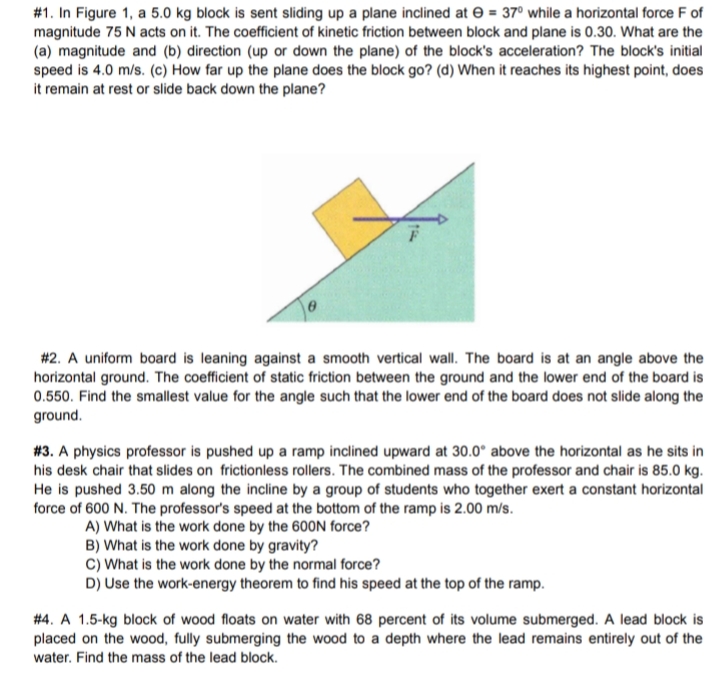# 3. A physics professor is pushed up a ramp inclined upward at 30.0° above the horizontal as he sits in his desk chair that slides on frictionless rollers. The combined mass of the professor and chair is 85.0 kg. He is pushed 3.50 m along the incline by a group of students who together exert a constant horizontal force of 600 N. The professor's speed at the bottom of the ramp is 2.00 m/s. A) What is the work done by the 600N force? B) What is the work done by gravity? C) What is the work done by the normal force? D) Use the work-energy theorem to find his speed at the top of the ramp.
# 3. A physics professor is pushed up a ramp inclined upward at 30.0° above the horizontal as he sits in his desk chair that slides on frictionless rollers. The combined mass of the professor and chair is 85.0 kg. He is pushed 3.50 m along the incline by a group of students who together exert a constant horizontal force of 600 N. The professor's speed at the bottom of the ramp is 2.00 m/s. A) What is the work done by the 600N force? B) What is the work done by gravity? C) What is the work done by the normal force? D) Use the work-energy theorem to find his speed at the top of the ramp.
Physics for Scientists and Engineers: Foundations and Connections
1st Edition
ISBN:9781133939146
Author:Katz, Debora M.
Publisher:Katz, Debora M.
Chapter5: Newton's Laws Of Motion
Section: Chapter Questions
Problem 40PQ: A sleigh is being pulled horizontally by a train of horses at a constant speed of 8.05 m/s. The...
Related questions
Question
Pls help me answer number 3 letter D complete solution

Transcribed Image Text:#1. In Figure 1, a 5.0 kg block is sent sliding up a plane inclined at e = 37° while a horizontal force F of
magnitude 75 N acts on it. The coefficient of kinetic friction between block and plane is 0.30. What are the
(a) magnitude and (b) direction (up or down the plane) of the block's acceleration? The block's initial
speed is 4.0 m/s. (c) How far up the plane does the block go? (d) When it reaches its highest point, does
it remain at rest or slide back down the plane?
#2. A uniform board is leaning against a smooth vertical wall. The board is at an angle above the
horizontal ground. The coefficient of static friction between the ground and the lower end of the board is
0.550. Find the smallest value for the angle such that the lower end of the board does not slide along the
ground.
# 3. A physics professor is pushed up a ramp inclined upward at 30.0° above the horizontal as he sits in
his desk chair that slides on frictionless rollers. The combined mass of the professor and chair is 85.0 kg.
He is pushed 3.50 m along the incline by a group of students who together exert a constant horizontal
force of 600 N. The professor's speed at the bottom of the ramp is 2.00 m/s.
A) What is the work done by the 600N force?
B) What is the work done by gravity?
C) What is the work done by the normal force?
D) Use the work-energy theorem to find his speed at the top of the ramp.
#4. A 1.5-kg block of wood floats on water with 68 percent of its volume submerged. A lead block is
placed on the wood, fully submerging the wood to a depth where the lead remains entirely out of the
water. Find the mass of the lead block.
Expert Solution
This question has been solved!
Explore an expertly crafted, step-by-step solution for a thorough understanding of key concepts.
This is a popular solution!
Trending now
This is a popular solution!
Step by step
Solved in 2 steps with 2 images

Knowledge Booster
Learn more about
Need a deep-dive on the concept behind this application? Look no further. Learn more about this topic, physics and related others by exploring similar questions and additional content below.Recommended textbooks for you

Physics for Scientists and Engineers: Foundations…
Physics
ISBN:
9781133939146
Author:
Katz, Debora M.
Publisher:
Cengage Learning

Principles of Physics: A Calculus-Based Text
Physics
ISBN:
9781133104261
Author:
Raymond A. Serway, John W. Jewett
Publisher:
Cengage Learning

Glencoe Physics: Principles and Problems, Student…
Physics
ISBN:
9780078807213
Author:
Paul W. Zitzewitz
Publisher:
Glencoe/McGraw-Hill

Physics for Scientists and Engineers: Foundations…
Physics
ISBN:
9781133939146
Author:
Katz, Debora M.
Publisher:
Cengage Learning

Principles of Physics: A Calculus-Based Text
Physics
ISBN:
9781133104261
Author:
Raymond A. Serway, John W. Jewett
Publisher:
Cengage Learning

Glencoe Physics: Principles and Problems, Student…
Physics
ISBN:
9780078807213
Author:
Paul W. Zitzewitz
Publisher:
Glencoe/McGraw-Hill

College Physics
Physics
ISBN:
9781285737027
Author:
Raymond A. Serway, Chris Vuille
Publisher:
Cengage Learning